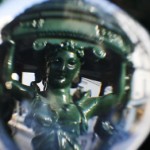I could be the catalyst that sparks the revolution
I could be an inmate in a long-term institution
I could dream to wide extremes, I could do or die
I could yawn and be withdrawn and watch the world go by
What a waste
— Ian Dury
ONE OF THE KEYS to the delineation of any Centaur is understanding how and why they die. In nearly every myth involving a Centaur, he or she dies or is killed. Death in this sense stands in for the idea of how we go about the process of change or transition that is so essential to Centaurs as astrological factors. There is almost always a complicated psychological and emotional process involved. Each Centaur speaks to one or more versions of that process.
 Hylonome (pronounced hy-la-na-me) chooses to kill herself, the only Centaur I know of who commits intentional suicide. There are two myths that come close, however. Pholus kills himself ‘accidentally’ when out of curiosity he picks up a poison arrow and drops it on his foot. It is a kind of reckless suicide. Chiron, after a long struggle with a mortal wound, makes an arrangement with Zeus to leave his immortal physical body and be incarnated on another plane of reality, ‘in heaven’, as it were. His choice is voluntary but could not properly be called suicide.
Hylonome (pronounced hy-la-na-me) chooses to kill herself, the only Centaur I know of who commits intentional suicide. There are two myths that come close, however. Pholus kills himself ‘accidentally’ when out of curiosity he picks up a poison arrow and drops it on his foot. It is a kind of reckless suicide. Chiron, after a long struggle with a mortal wound, makes an arrangement with Zeus to leave his immortal physical body and be incarnated on another plane of reality, ‘in heaven’, as it were. His choice is voluntary but could not properly be called suicide.
Hylonome kills herself after her consort, the alpha male of the Centaurs Cyllarus, is killed. There are two versions of the death of Cyllarus — one where he is killed in battle, and another where he is struck by a spear that comes out of nowhere. Hylonome is there in both versions, but she cannot save him. Both myths are interesting and applicable, but to me the ‘out of nowhere’ version is the more salient.
We know how Hylonome dies: she kills herself, out of grief, on the same javelin that killed Cyllarus. She chooses to die — but does she really choose? Or are there other influences?
Melanie Reinhart points out that this resembles the practice in India sometimes called sati, where a widow supposedly chooses to be burned on her husband’s funeral pyre. The practice has its origin in the myth of Shiva and Sati. It’s a complicated myth, but Shiva was insulted by Sati’s father, who had rejected him in front of all the other gods. She could not take the insult; so she spontaneously combusted.
Sati transformed out of myth and became a horrible crime by society and culture where widows were either forced to jump in the pyre or live a lifeless life — shunned. While the practice is obviously long abolished, the scar is still exists. The term sati is also sometimes interpreted as “chaste woman.”
In the myth of Cyllarus and Hylonome, we have on the surface a story about the subjugation of a woman’s life to that of a man. Hylonome was a strong, passionate woman Centaur (there were not many) who might have been a symbol of unbridled female passion. But she seems to have done the inevitable, which was fall in love with the alpha-male of the Centaurs. Then she kills herself on the spear that killed him. We get perhaps an early myth in the cycle that inspired Romeo and Juliette or any number of tragedies.
Their deaths are senseless. We indulge this raw, naked stupidity of loss like pornography: loss for its own sake.
Looking at the total story of her life, it’s almost as if she had all this potential and then threw it away on some bloke. So, what is being grieved in the myth of Cyllarus and Hylonome?
Is it their deaths, or the lost potential of their lives? Or is it the lost potential of Hylonome in her choices? The loss of a beautiful man, by chance or in battle, like so many fall? Is it the loss of their relationship, another chapter in the saga of lovers who just die for no reason? Well, all of the above. The message is, it’s a waste.
Waste is one of the hardest things to accept — the meaninglessness of it gnaws away at one’s mind and feelings, because the mind insists on trying to make sense, construct a meaningful story, out of everything, and with things like this it can’t; and so it goes into a kind of spin. I think that’s how Hylonome’s mind came up with her solution, to kill herself; it really seemed like one to her.
Tracy Delaney wrote in a recent essay on Cyllarus and Hylonome, “She may be someone for whom endings are inconceivable, incomprehensible, just totally out of the question (Neptune acknowledges no boundaries). Or she may simply be what any of us might feel at the time of the initial shock and disbelief.”
We can sum up Hylonome’s role in the myth effectively in two words: self-inflicted. This infliction may exist as part of a family pattern — that is, the family inflicts injury on itself and its members. For many years through the 1950s and 1960s, Nessus and Hylonome were in a long conjunction that moved through Taurus and in to Gemini. We need to be mindful that a great many of us have this conjunction in our natal charts and need to distinguish the energies consciously (as with any conjunction).
My take on the conjunction is that it’s about admitting the abuse inflicted on the generations that came through the divorce era of Western society (which has not ended, but the trend seems to have really gained steam with this conjunction), and then the ways in which we took that abuse on, and continue to inflict it on ourselves. In this conjunction, there is the quality of the victim continuing to inflict the perpetrator’s injury on perself. Look to Quaoar for additional details of the family pattern that might be involved.
Mass Grief; The Cry of the Poor
We see themes of mass grief showing up in Hylonome. Taking a chart that is perhaps the most historically famous event involving mass grief in modern history, the Kennedy assassination [Nov. 22, 1963, 12:30 pm, Dallas, TX), we find Hylonome early in the 4th house (the ancient house of fathers; the house of home). Nessus in early Gemini is close to the nadir in the 3rd house. Hylonome represents the emotional and security aspect of this injury, and Nessus the psychological aspect.
Juan Revilla gives the keywords “the cry of the poor” to describe Hylonome, which were demonstrated during the Scorpio New Moon of Nov. 12, 2004. In Astrology Secrets Revealed of Nov. 19, 2004, I wrote:
The most significant news was the passing of Rahman Abdel-Raouf Arafat Al-Qudwa on Thursday morning, known to the world as Yasser Arafat: terrorist to some, hero to others, and Nobel Prize winner. This will, no doubt, shuffle the deck on the balance of power in the Middle East. He died of unknown causes during the exact aspect of Moon occult Mars in the final degree of Libra, fitting astrology for the death of a warrior. There is much speculation about the cause of death, which is not being released at this time. The morning of Arafat’s passing, the Moon and Mars proceeded directly into Scorpio, joining the Sun. The next day (Friday) was the Scorpio New Moon. With this lunation applying to within one degree of orb (that is, at the very end of the lunar cycle), Arafat’s body arrived at Ramallah on the Gaza Strip amidst a crowd of tens of thousands of Palestinian men firing automatic weapons into the air for two hours, and was buried per Muslim law before sunset on the first day after his death.
The New Moon occurred tightly conjunct the centaur planet Hylonome, which has associations with grief and mass appeal. When research astrologers see extremely rare world events such as this combine with the prominent astrology of a relatively new planet, this is how they come to understand that planet’s significance. It is a slow process, but it has its transcendent moments. That Arafat’s funeral occurred in the last moments before a Scorpio New Moon is stunning enough. However, the presence of Hylonome speaks to the grief created by this seemingly endless, unbearably violent struggle between the Palestinians and the Israelis.















